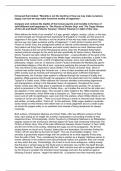Immanuel Kant stated, “Morality is not the doctrine of how we may make ourselves
happy, but how we may make ourselves worthy of happiness”.
Compare and contrast the depths of the human psyche and morality in the face of
self-fulfilment and happiness in ‘The Picture of Dorian Gray’ and ‘The Tragic History
of the Life and Death of Doctor Faustus’ (‘Doctor Faustus’) in light of this view.
What defines the limits of our morality? Is it age, gender, religion, society, culture, or the way
we were brought up? Immanuel Kant expresses his thoughts on morality and the pursuit of
happiness in the quote, “Morality is not the doctrine of how we may make ourselves happy,
but how we may make ourselves worthy of happiness”. In both Doctor Faustus and The
Picture of Dorian Gray, the protagonists exhibit an internal conflict between achieving what
they believe will bring them happiness and what society deems as moral. Marlowe wrote
Doctor Faustus at the end of the Renaissance period, when the Protestant Reformation
caused profound changes for the world but also specifically for literary history. Marlowe’s
Doctor Faustus has been called the ‘Renaissance Man’ - a personification of the spirit of the
Renaissance, encasing a revolt against the Middle Ages’ restrictive authorities, a belief in the
potential of the human mind, a spirit of intellectual curiosity, and a new individuality in life,
philosophy, religion, and art. In essence, Doctor Faustus embodies the Morality play genre -
a dramatised allegory of the life of men, commonly exploring the concept of psychomachia.
This very theme is also explored in Oscar Wilde’s The Picture of Dorian Gray, which in
contrast was written during the Victorian era - a time of class anxieties and double standards
within society such as honesty and transparency not being given sufficient importance.
Predominantly, the Victorian class system is reflected through the concept of duality and
duplicity; Wilde explores this through the separation of the aristocrats from the middle class.
Typical of a Gothic novel, Wilde explores the Victorian anxieties surrounding degeneracy
and transgression, linking to the Darwinian theory of regression, throughout the novel.
Gothic novels also often take place in significant or clashing time periods, Fin de Siècle -
which is prominent in The Picture of Dorian Gray - as it implies the end of the old order and
the adoption of new radical ideas. This concept is often implied to the 1880s Aesthetic and
Decadent movements, which Wilde was a champion on. There was a focus on decadence,
luxury and art with its significance, seen even from the preface, where Wilde reflects on the
concept of ‘art for art’s sake’: ”There is no such thing as a moral or immoral book. Books are
well written, or badly written. That is all.” In this aphorism, Wilde urges readers to evaluate
books strictly on their literary merit rather than on a moral judgement and on a wider scale:
art should be judged solely on an aesthetic level instead of being deciphered for deeper
meanings.
Both authors, Christopher Marlowe and Oscar Wilde, offer two different versions of their
texts, each acting as an insight into society’s expectations surrounding morality at their
respective times. Chronologically, Doctor Faustus by Christopher Marlowe is an Elizabethan
tragedy, based on the anonymous German legend of Faust, that immensely influenced The
Picture of Dorian Gray. One of the main differences between Doctor Faustus’ A-Text (1604)
and B-Text (1616) is the ending, reflecting the tragic end of the protagonist. The B-Text
ending leaves no doubt as to Faustus’ destruction and damnation; the scholars finding his
“limbs / All torn asunder by the hand of death”. The use of animalistic imagery, “torn,”
provides a gruesomely explicit image with the audience as to what happens if they stray
from the path of God. Thus, considering the play’s position as a tragedy, Marlowe seems to
invoke catharsis in the audience and subconsciously makes one question their own morals
as they watch the play. Contrastingly, the A-text is much more ambiguous, stating merely
that Faustus is carried away by the devils and no witnesses can confirm his death through
the stage direction “Exeunt [Devils] with him”. Both versions end with an epilogue delivered
by the chorus to proclaim the intended moral message and warn the audience against
following Faustus’ actions: “regard his hellish fall…to practise more than heavenly power




